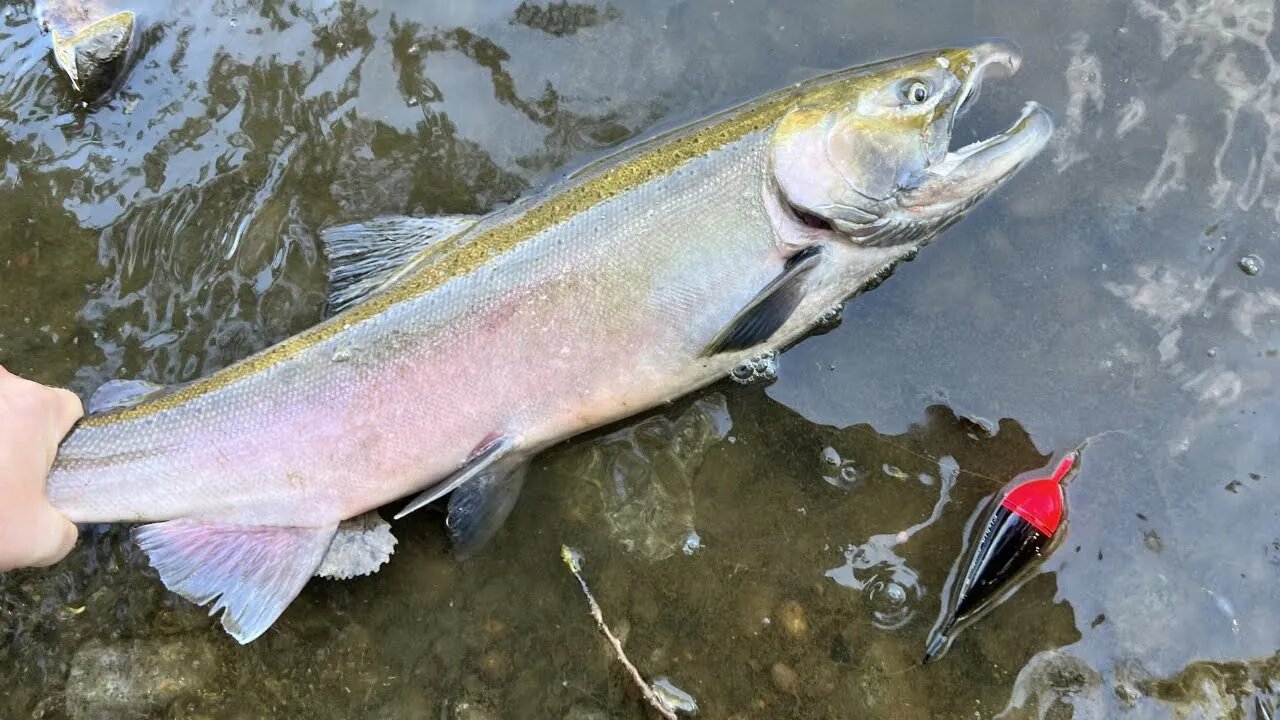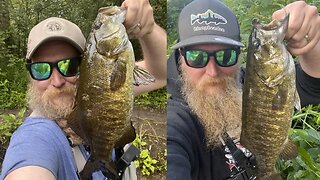Premium Only Content

Float Fishing For Coho + Bonus Fish / Skein & Beads / The Tail End Of The 2022 Michigan Salmon Run
It's the tail end of the 2022 Michigan Salmon Run and I am taking advantage of my last chance to get some Coho with a chance of steelhead or king salmon being mixed in. Salmon fishing slowed to a hault after some warm weather and most fish left in the rivers now are transitioned to gravel or dead. a sew more salmon will trickle in before winter but for the most part the 2022 Great Lakes Salmon Run is over. Across the state low water is making steelhead fishing poor for the most part so I am in a rut at the moment but expect to find a few salmon or steelhead that will take a bait any day now lol.
Thanks for watching and stay tuned for more Michigan Fishing Videos!
Michigan salmon fishing attracts people from all around the country who wish to chase Great Lakes Salmon. I drive all over the state early in the season every year to fish for king salmon and coho salmon but fishing for coho salmon is my favorite of the 2. In this salmon fishing video I catch my first few coho of 2022 while centerpin float fishing with skein and bead combos. Float fishing for salmon is fun and effective and skein and beads make great salmon baits.
For More Michigan salmon fishing videos make sure to subscribe and stay tuned as I continue to add more Michigan salmon fishing content!
Coho’s typically migrate later than the other salmon and travel longer distances. Although natural reproduction has been documented, the fishery is largely sustained through stocking. The bulk of coho are planted in the Platte River, just downstream from the state's coho hatchery.
Depending on the tributary, coho spawning runs occur from early September to November. Females excavate redds, or nests, in tributary stream gravel beds. Both male and female adults die soon after spawning. The next spring the eggs hatch and the young remain in the gravel for two to three weeks. They emerge in the late spring, as fry, and wait until their second spring before descending to the Great Lakes as smolts. Once in the lakes, they may stay near shore for a few months, and then seek deeper waters.
This is the fish that really started the Great Lakes salmon fishery. Like Chinook, coho are native to the Pacific coast of North America and parts of Asia. They were successfully introduced into the Great Lakes in 1966, when smolts where stocked in two Lake Michigan tributary streams; Platte River and Bear Creek (Big Manistee River tributary). There was excitement from anglers and fish managers when coho made their first spawning run in the fall of 1967. Since that time, the coho has become a popular sport fish, and many people come from all over the world to fish Michigan's great coho fishery.
This history of the salmon in the Great Lakes describes the decline and extinction of the Atlantic salmon (Salmo salar) in Lake Ontario in the 1800's; the failure to establish, by salmon culture, permanent or sizable populations of Atlantic or Pacific salmon in any of the Great Lakes in 1867-1965; and the success of the plantings of coho (Oncorhynchus kisutch) and chinook salmon (O. tshawytsha) in the Great Lakes, in 1966-70 -- particularly in Lake Michigan. Despite plantings of 5 million fry and fingerlings from Lake Ontario stocks in 1866-84, the native Atlantic salmon in Lake Ontario became extinct in the late 1800's primarily because tributaries in which they spawned were blocked by mill dams. Plantings of 13 million chinook salmon and landlocked and anadromous forms of Atlantic salmon in Lake Ontario and the other Great Lakes in 1873-1947 failed completely. The first species to develop a self-sustaining population was the pink salmon (O. gorbuscha), which was planted in Lake Superior in 1956; however, it has not become abundant. A salmon fishery finally was established when 15 million coho salmon and 6 million chinook salmon were planted as smolt in the Great Lakes in 1966-70. In 1970, for example, 576,000 coho salmon (12% of those planted in 1969) were caught by anglers in Lake Michigan. Most weighed 5 to 10 pounds (2.3-4.5 kg). Sport fishing for salmon was fair in Lakes Superior and Huron, and poor in Lakes Erie and Ontario. By 1970, natural reproduction of coho, chinook, pink, and kokanee (O. nerka) salmon had occurred in some tributaries of one or more of the upper three Great Lakes. It is expected, however, that the sport fishery will continue to be supported almost entirely by planted fish.
centerpin float fishing, float fishing for coho, salmon fishing with skein, float fishing for coho, skein fishing, skein fishing set up, skein fishing rig,
michigan salmon fishing,coho salmon fishing michigan,lake michigan salmon fishing,coho salmon fishing,manistee river salmon fishing,salmon fishing 2022,salmon fishing michigan,salmon fishing michigan 2022,michigan fishing,betsie river salmon fishing,grand river salmon fishing,grand river fishing,fishing michigan,michigan steelhead fishing,salmon fishing michigan rivers,michigan fishing videos,salmon fishing michigan season,
-
 10:03
10:03
Michigan fishing videos
1 year ago $0.05 earnedFloat Fishing For Smallmouth Bass / Jig & Bobber Fishing For River Bass / Michigan Bass Fishing
8171 -
 1:46:16
1:46:16
Redacted News
5 hours agoRFK CONFIRMATION: Kennedy goes to WAR with Big Pharma Democrats in Fiery Hearing | Redacted Live
156K309 -
 57:31
57:31
Candace Show Podcast
6 hours agoBREAKING! Taylor Swift Turns Against Blake Lively & Ryan Reynolds | Candace Ep 141
164K169 -
 1:04:59
1:04:59
Sarah Westall
3 hours agoRFK Jr Report, Constitution Suspended, War Time Procedures in Place, WHO Exit, DOD w/ Sasha Latypova
14.5K16 -
 1:56:37
1:56:37
Melonie Mac
7 hours agoGo Boom Live Ep 35!
28K9 -
 1:01:13
1:01:13
LFA TV
10 hours agoPRESIDENT TRUMP SIGNS LAKEN RILEY ACT | BASED AMERICA 1.29.25 6pm
42K6 -
 1:43:07
1:43:07
2 MIKES LIVE
4 hours ago2 MIKES LIVE #172 News Breakdown Wednesday!
16.4K2 -
 1:26:16
1:26:16
The Big Mig™
5 hours agoJ6’r Ryan Samsel Free At Last The BOP & DOJ Exposed
18.3K3 -
 31:34
31:34
The Based Mother
5 hours ago $0.70 earnedEXECUTIVE ORDER MUTILATES GENDER IDEOLOGY! Trump’s pulling out all the stops.
12.9K2 -
 1:05:44
1:05:44
The Amber May Show
22 hours ago $0.95 earnedSaving The Innocence | Rescuing Children From Rape Trafficking | Alan Smyth
15.4K3